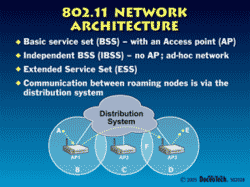|
802.11 Wireless LAN Trends and Technologies TM
|
|

|
An advanced class
covering the Wireless LAN standards that are most relevant to your
next design project. |
|
Course
Description:
This course will provide the student with broad knowledge on
current Wireless LAN (WLAN) standards, trends, issues and
technologies. We have included content that is emerging from
recent IEEE 802.11 WLAN working group meeting and letter ballots.
These are the critical topics for todays development projects.
Other courses may spend most of their time on the early WLAN
specifications published between 1997 through 2003, but this
course is squarely focused on the newer specifications that will
affect the current and future applications for wireless LANs.
Audience:
This course is carefully designed for both beginner and
intermediate students who are working on Wireless-LAN-related
products and services, or expect to be on those projects soon.
A student who is just beginning to work on Wireless LAN (Wi-Fi)
projects will gain a full understanding of the entire set of WLAN
standards. A student who has already taken an introductory WLAN
course will receive a crucial update on the latest 802.11 issues
and specifications, in the context of those earlier
specifications.
|
|
This DoceoTech course was authored by Dr. Todor Cooklev, who is a
contributor to and voting member of the IEEE 802.11 and 802.15
committees. Dr. Cooklev was chosen by the IEEE to write their
definitive book that covers all wireless standards, which is named
Wireless Communication Standards: A Study of IEEE 802.11,
802.15, 802.16.
|
|
Two-day Course
Outline: |
-
Course Objective: The latest 802.11 innovations

-
The latest in Security and 802.11i
-
Roaming (802.11f) and the recent fast roaming proposals (802.11r)
-
Access mechanisms, QoS and 802.11e
-
Radio resource management: 802.11k
-
Wi-Fi Mesh networks and 802.11s
-
Physical layers: 802.11b, 802.11a, 802.11g review
-
802.11n for Wi-Fi at 100 Mb/s+
-
Throughput and throughput limits
-
Multiple Input Multiple Output (MIMO)
techniques
-
Wireless LAN architecture and installation options
-
Testing and performance prediction: 802.11t
-
Wireless access for the vehicular environment (WAVE): 802.11p
-
Interworking with external networks: 802.11u
-
Voice over 802.11 (VoWiFi)
|
|
At the successful completion of this course, the student should be
able to:
Contribute effectively to the WLAN design projects that implement
or support the newest standards
Evaluate, and choose among, design options and tradeoffs that are
presented in the latest WLAN specifications
List the significance of each IEEE 802 wireless Working Group and
standard amendment, from 802.11a through 802.11v
through 802.11v
Compare and contrast the WLAN security evolution steps from Wired
Equivalent Privacy to Wi-Fi Protected Access to 802.11i
Diagram the process of roaming between Access Points with 802.11f
Explain how the CSMA/CA Medium Access Control procedures are
amended with 802.11e Quality of Service approaches to support
Voice over Wi-Fi
Map the evolution of 802.11b to 802.11g in the 2.4 GHz band, and
the migration from 802.11a to 802.11h to 802.11n in the 5 GHz band
Comment on current WLAN Implementation and management issues
|
|